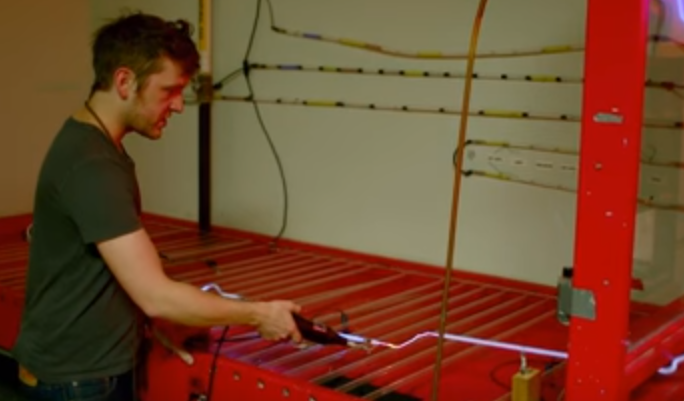BTN.com staff, March 18, 2016
During football and basketball games, BTN LiveBIG will spotlight notable examples of research, innovation and community service from around the conference. In-Game stories will provide more background on these features, and the opportunity to view the videos again.
It?s hotter than molten lava, constantly moving and requires artisans to work in a careful precision with their tools, their space and each other. It?s glass, and no other university has shaped its future as an artistic medium longer than the University of Wisconsin.
?It started around 1962, and Harvey Littleton is really well known for being the founder of the Glass Lab [at Wisconsin] and kind of bringing this process from the factory to academia,? said Helen Lee, the Glass Lab?s current director.
Littleton, who grew up in Corning, N.Y., just a stones-throw from the famous Corning Glassworks, was already an accomplished ceramist and instructor at the university when his interest in glassblowing took hold. Prior to the advent of the American Studio Glass movement, glass art was largely done in industrial settings, with skilled craftsmen turning out large numbers of beautiful but largely household-oriented pieces such as goblet, bowls and decanters.
After organizing the first glass-art seminar at the Toledo Museum of Art, Littleton secured funding for a small but fully equipped studio just off Wisconsin?s campus in Madison. The independent study program that grew out of that little studio quickly amassed a following of devoted students and became the first academic glass-art program in the U.S.
?The first generation of people that studied in that program went on to propagate and make more glass programs all over the country,? Lee said.
Today, Wisconsin?s glass department is still among the nation?s leading programs, attracting students that want to work with this most unique of mediums.
?It?s been a total whirlwind of successes and failures,? said Heather Sutherland, a graduate student in the program. ?But the failures have been more successful than my successes. I?ve learned a lot of life lessons. The idea of taking it slow, the ideas of repetition and being consistent have been important things that I?ve learned through glass blowing.?
Both Sutherland and fellow student Tyler Gordon point to the process of creating as a motivating factor in why they choose to work with glass.
?The craft is not necessarily just object making,? Gordon explained. ?A lot of the making we do is performative in nature. When we?re in the shop, it?s a dance, it?s two or more people working together, moving around each other and across each other, making a pattern across the shop.?
[btn-post-package]That recognition of the artistry inherent in the process is one of the very things that Lee is trying to instill in her students. While she acknowledges the allure of the glitzy glass sculptures that she calls ?pop culture glass,? Lee wants her students to walk away from the program with more than just the knowledge of how to make a ?glowing orb of orange stuff.?
?Making is a process of thinking,? she said. ?Working with this material has a very specific history to it as well as a specific language to it in terms of what you can do. When I think about what I?m teaching them, I?m not teaching the students how to make a certain shape; I?m teaching them how to use their bodies to work with a material that?s changing dynamically.?
Watch the one-minute video above to see the process in action.
By John Tolley








